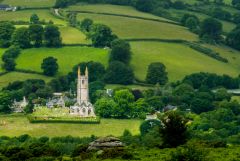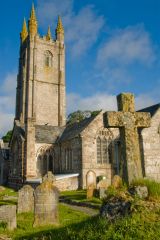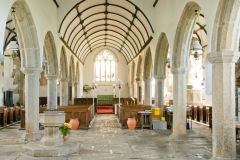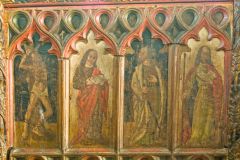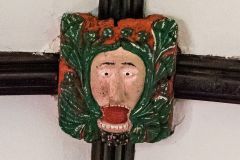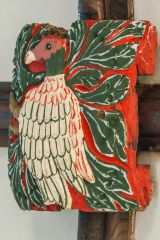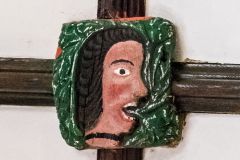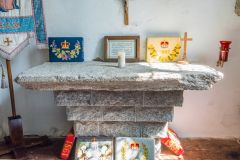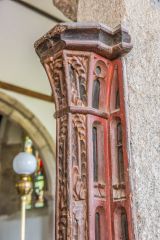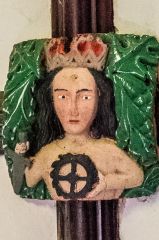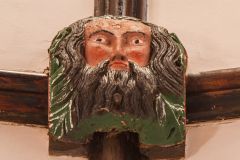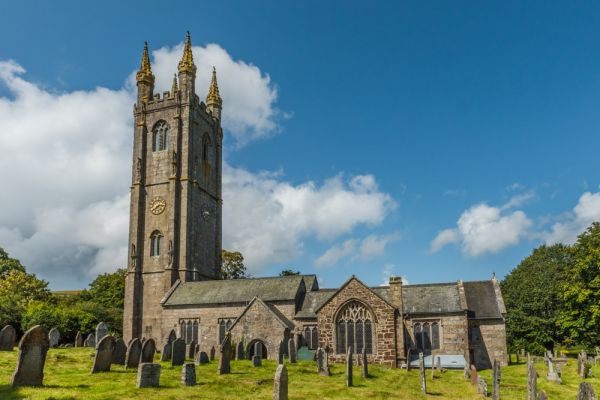
The 14th-century church of St Pancras in the pretty Dartmoor village of Widecombe-in-the-Moor is known as 'The Cathedral of the Moor' for its size and its striking 135-foot high tower. St Pancras church is thought to be the most visited parish church in England.
The church was built in the 14th century using granite from local quarries. It was extended several times over the following 200 years, reflecting the prosperity of the Dartmoor tin-mining trade. The most obvious reminder of the tin trade is a famous roof boss in the chancel, painted to resemble a circle of three hares sharing three ears between them. The Three Hares symbol was often called the Tinners Rabbits.
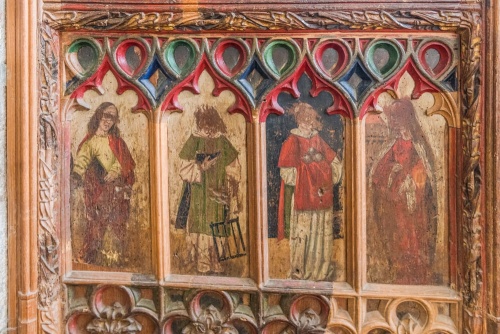
The striking tower rises in 3 stages, supported by offset buttresses topped by decorative pinnacles. There are more pinnacles at each corner of the crenellated top of the tower.
The Great Thunderstorm of 1638
Tragedy struck St Pancras church in 1638 when it was struck by lightning during a service, damaging the nave and chancel, killing 4 people, and injuring another 60. this 'Great Thunderstorm' toppled the north-east pinnacle of the tower into the nave. Several bell clappers in use at the time are now on display in the south transept. The tragic event is commemorated in verse painted on boards near the west door of the tower.
The disastrous lightning strike was blamed on the Devil. According to a popular local tale, the Devil came to Widecombe to claim the soul of a gambler who had fallen asleep during the church service. The Devil tethered his horse to the pinnacle, snatched the unfortunate sinner from the church, and hurled a fireball into the church nave. His horse bolted in fear, tearing the pinnacle loose. It fell into the nave, killing the unlucky worshippers.
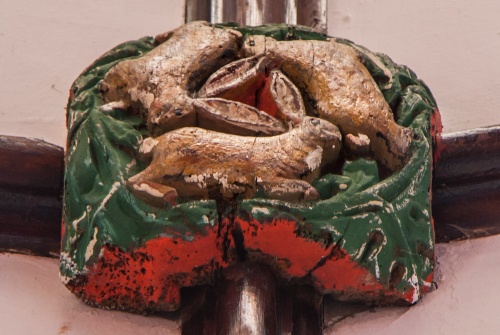
Set into the floor are grave slabs of Roger Hill and his wife, who lost their lives in the Great Thunderstorm tragedy.
Near the west door of the church is a plough, a reminder of the importance of agriculture to the inhabitants of Dartmoor. Every year there is a special Plough Sunday Service in which young farmers haul the plough down the church nave and the congregation asks for God's blessing on their crops for the forthcoming year.
The interior has wagon roofs throughout, and the nave and aisles terminate in the lower part of medieval wooden screens, painted with Biblical figures. The upper section of the screen was cut off sometime in the late 18th or early 19th century. The base sections are well-preserved, though the paint has faded in places. You can clearly see the painted figures of saints and martyrs including Matthew, Jerome, Gregory, Peter, Paul, Augustine and Mary Magdalen.
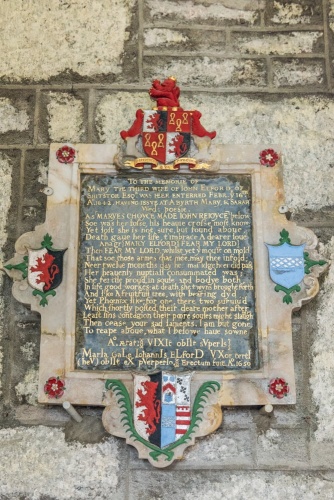
The oak communion rails were made with timbers from the roof of a medieval tithe barn in Chardstock, owned by the powerful Bishops of Sarum.
In the Chapel of St Catherine at the east end of the south aisle is an altar made from a medieval altar stone. The stone was discovered buried in the floor of the south transept, probably to prevent it from being destroyed by iconoclasts during the English Reformation.
Medieval Roof Bosses
There are several very nicely carved 17th-century grave slabs, but the real treasure here has to be the painted medieval roof bosses. Designs include the crowned figure of Christ, St Catherine of Alexandria with her wheel, the head of a bearded man, a goat, a Tudor rose, a chicken, and four examples of a Green Man. One of the Green Men figures is unusually shown in profile rather than facing the viewer.
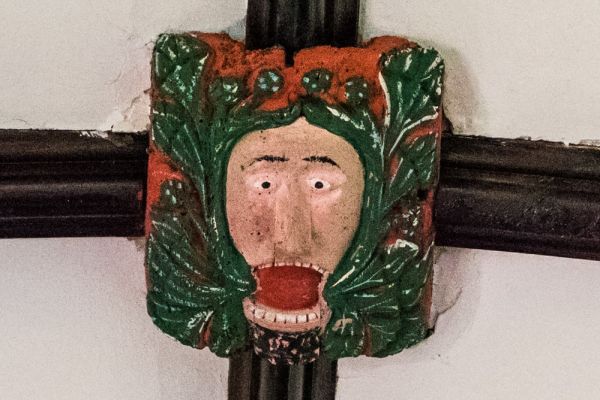
Bosses depicting birds and animals probably derive from medieval bestiaries. Aside from the Tinners Rabbits mentioned above, there are also figures of a lion, an antelope, a Pelican-in-her-Piety, and a crested bird that may represent a cock or perhaps a hoopoe, both of which often appeared in bestiaries.
The bosses in the chancel were paid for by the church patron or the incumbent clergyman, while those at the east end of the nave were paid for by the parishioners.
The most interesting memorial is a wall monument to Mary Elford, who died in 1650. The memorial has a touching inscription by her husband John Elford that reads;
"As Mary's choice made John rejoice below,
So was her loss his heavy cross most know,
Yet lost she is not sure, but found above,
Death gave her life, to embrace a dearer love"
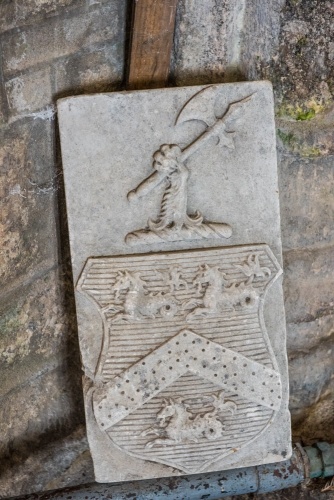
The Tucker Stone
Under the tower are several ancient stone crosses, and a curious 18th-century carved stone known locally as The Tucker Stone, which bears the coat of arms of the Tucker family, the lords of the manor at Natsworthy.
The Tuckers gave sizeable sums of money to the upkeep of the church and intended the stone to be incorporated into the pulpit. The vicar and churchwardens decided that having a family coat of arms built into the pulpit was a bit over the top, at which point the stone mysteriously disappeared.
The stone was lost until 1930 when it was discovered buried under a wall in the vicarage garden. It disappeared again, only to turn up in a broom cupboard at the National Trust's Church House. It was finally put on display in the church porch some 120 years after it was carved. The stone depicts the Tucker family arms; a blue chevron with 3 silver sea horses beneath a lion's arm holding a battle axe.
The Tucker family vault stands in the churchyard close to the lych gate.
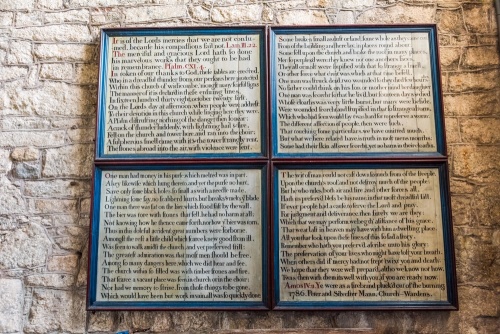
Widecombe parish covered a large area of the rugged Dartmoor landscape. This caused great hardship for people travelling to worship, who had to walk great distances. Church House, just outside the churchyard, was built in 1537 to offer food, ale and a place to rest for parishioners travelling great distances. Church House is now a community centre, though owned by the National Trust
Getting There
The church is located in the centre of the village, just past the large village green on the B3387. There are two pay and display parking areas around the green. The church is usually open daylight hours.
About Widecombe-in-the-Moor
Address: Widecombe-in-the-Moor,
Dartmoor,
Devon,
England, TQ13 7TA
Attraction Type: Historic Church
Location: On the B3387 in the centre of Widecombe. Parking available. Usually open to visitors.
Website: Widecombe-in-the-Moor
Location
map
OS: SX718767
Photo Credit: David Ross and Britain Express
HERITAGE
 We've 'tagged' this attraction information to help you find related historic attractions and learn more about major time periods mentioned.
We've 'tagged' this attraction information to help you find related historic attractions and learn more about major time periods mentioned.
Historic Time Periods:
Find other attractions tagged with:
14th century (Time Period) - 17th century (Time Period) - 18th century (Time Period) - Medieval (Time Period) - Tudor (Time Period) -
NEARBY HISTORIC ATTRACTIONS
Heritage Rated from 1- 5 (low to exceptional) on historic interest
Church House - 0 miles (Historic Building) ![]()
Hound Tor Deserted Medieval Village - 2.1 miles (Historic Building) ![]()
Grimspound - 2.8 miles (Prehistoric Site) ![]()
Manaton, St Winifred's Church - 3.4 miles (Historic Church) ![]()
Dartmeet Clapper Bridge - 3.6 miles (Historic Building) ![]()
Bellever Forest and Clapper Bridge - 3.9 miles (Countryside) ![]()
Lustleigh, St John's Church - 5 miles (Historic Church) ![]()
Hembury Castle Hillfort - 5.2 miles (Prehistoric Site) ![]()
Nearest Holiday Cottages to Widecombe-in-the-Moor:
Widecombe-in-the-Moor, Devon
Sleeps: 4
Stay from: £541 - 2475
More self catering near Widecombe-in-the-Moor
